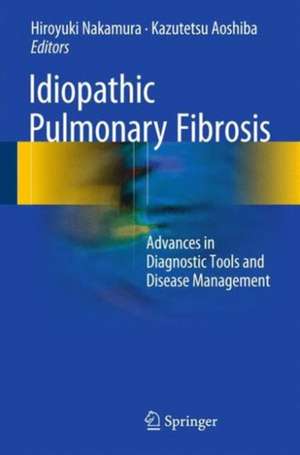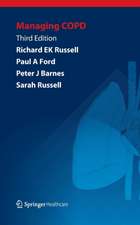Idiopathic Pulmonary Fibrosis: Advances in Diagnostic Tools and Disease Management
Editat de Hiroyuki Nakamura, Kazutetsu Aoshibaen Limba Engleză Hardback – 8 oct 2015
| Toate formatele și edițiile | Preț | Express |
|---|---|---|
| Paperback (1) | 651.37 lei 6-8 săpt. | |
| Springer – 23 aug 2016 | 651.37 lei 6-8 săpt. | |
| Hardback (1) | 667.04 lei 38-44 zile | |
| Springer – 8 oct 2015 | 667.04 lei 38-44 zile |
Preț: 667.04 lei
Preț vechi: 702.16 lei
-5% Nou
Puncte Express: 1001
Preț estimativ în valută:
127.68€ • 138.73$ • 107.32£
127.68€ • 138.73$ • 107.32£
Carte tipărită la comandă
Livrare economică 17-23 aprilie
Preluare comenzi: 021 569.72.76
Specificații
ISBN-13: 9784431555810
ISBN-10: 4431555811
Pagini: 240
Ilustrații: X, 259 p.
Dimensiuni: 155 x 235 x 20 mm
Greutate: 0.66 kg
Ediția:1st ed. 2016
Editura: Springer
Colecția Springer
Locul publicării:Tokyo, Japan
ISBN-10: 4431555811
Pagini: 240
Ilustrații: X, 259 p.
Dimensiuni: 155 x 235 x 20 mm
Greutate: 0.66 kg
Ediția:1st ed. 2016
Editura: Springer
Colecția Springer
Locul publicării:Tokyo, Japan
Public țintă
Professional/practitionerCuprins
Part 1.- Definition, epidemiology, and pathogenesis
.- Chapter 1: Definition of IPF (Question: Is the latest classification [ATS/ERS] satisfactory?).- Chapter 2: Epidemiology and risk factors of IPF (Question: Can we dare to ask, “What are the possible causes?”).- Chapter 3: Acute exacerbation of IPF (Question: The concept was proposed in Japan, but why was it not recognized in western countries?).- Chapter 4: Pathogenesis (Question: Is abnormal repair of epithelial damage involved in the basic pathogenesis of this disease?)
.- Part 2 Diagnosis
.- Chapter 5: Specific serum markers of IPF (Question: What are the significances of KL-6, SP-A, and SP-D?).- Chapter 6: High-resolution CT of honeycombing and IPF/UIP (Question: To what extent can honeycomb lung be diagnosed by imaging? To what extent can IPF diagnosis be made by HRCT?).- Chapter 7: Pathology of IPF (Question: Why does the pathological classification of IIPs vary among pathologists?).- Chapter 8: Differential diagnosis (Question: What should we particularly keep in mind in the differential diagnosis?)
.- Part 3 Management and prognosis
.- Chapter 9 Pharmacotherapy of IPF (antifibrotic compounds) (Question: Can antifibrotic agents really inhibit fibrosis? How about the development of new therapeutic agents?).- Chapter 10: Pharmacotherapy of IPF (Corticosteroids, immunosuppressants) (Question: Are these actually effective? Ineffective? Harmful?).- Chapter 11: Non-pharmacological therapy for IPF (Question: Is respiratory care actually effective?).- Chapter 12: Pharmacotherapy of acute exacerbation of IPF (Corticosteroids, immunosuppressants and direct hemoperfusion with polymyxin B) (Question: Are high-dose steroid therapy, other immunosuppressant therapy, and PMX therapy [often used in Japan] really effective?)
.- Part 4 Topics
.- Chapter 13 :Combined pulmonary fibrosis and emphysema (CPFE) (Question:
Is it an independent disease entity?).- Chapter 14: Common pathways in IPF and lung cancer (Question: Why is lung cancer associated with IPF at a high frequency?).- Chapter 15 :Acute exacerbation of IIPs after pulmonary resection for lung cancer (Question: Can acute exacerbation of IPF be predicted preoperatively?)
.- Chapter 1: Definition of IPF (Question: Is the latest classification [ATS/ERS] satisfactory?).- Chapter 2: Epidemiology and risk factors of IPF (Question: Can we dare to ask, “What are the possible causes?”).- Chapter 3: Acute exacerbation of IPF (Question: The concept was proposed in Japan, but why was it not recognized in western countries?).- Chapter 4: Pathogenesis (Question: Is abnormal repair of epithelial damage involved in the basic pathogenesis of this disease?)
.- Part 2 Diagnosis
.- Chapter 5: Specific serum markers of IPF (Question: What are the significances of KL-6, SP-A, and SP-D?).- Chapter 6: High-resolution CT of honeycombing and IPF/UIP (Question: To what extent can honeycomb lung be diagnosed by imaging? To what extent can IPF diagnosis be made by HRCT?).- Chapter 7: Pathology of IPF (Question: Why does the pathological classification of IIPs vary among pathologists?).- Chapter 8: Differential diagnosis (Question: What should we particularly keep in mind in the differential diagnosis?)
.- Part 3 Management and prognosis
.- Chapter 9 Pharmacotherapy of IPF (antifibrotic compounds) (Question: Can antifibrotic agents really inhibit fibrosis? How about the development of new therapeutic agents?).- Chapter 10: Pharmacotherapy of IPF (Corticosteroids, immunosuppressants) (Question: Are these actually effective? Ineffective? Harmful?).- Chapter 11: Non-pharmacological therapy for IPF (Question: Is respiratory care actually effective?).- Chapter 12: Pharmacotherapy of acute exacerbation of IPF (Corticosteroids, immunosuppressants and direct hemoperfusion with polymyxin B) (Question: Are high-dose steroid therapy, other immunosuppressant therapy, and PMX therapy [often used in Japan] really effective?)
.- Part 4 Topics
.- Chapter 13 :Combined pulmonary fibrosis and emphysema (CPFE) (Question:
Is it an independent disease entity?).- Chapter 14: Common pathways in IPF and lung cancer (Question: Why is lung cancer associated with IPF at a high frequency?).- Chapter 15 :Acute exacerbation of IIPs after pulmonary resection for lung cancer (Question: Can acute exacerbation of IPF be predicted preoperatively?)
Notă biografică
Hiroyuki Nakamura, MD, PhD.
Department of Respiratory Medicine,
Tokyo Medical University Ibaraki Medical Center, Japan
Kazutetsu Aoshiba, MD, PhD.
Department of Respiratory Medicine,
Tokyo Medical University Ibaraki Medical Center, Japan
Department of Respiratory Medicine,
Tokyo Medical University Ibaraki Medical Center, Japan
Kazutetsu Aoshiba, MD, PhD.
Department of Respiratory Medicine,
Tokyo Medical University Ibaraki Medical Center, Japan
Textul de pe ultima copertă
From epidemiology and pathogenesis to disease management, this book reviews our current understanding of and provides up-to-date information of Idiopathic Pulmonary Fibrosis (IPF). A subtype of Idiopathic Interstitial Pneumonias (IIP), IPF is one of the most elusive and intractable respiratory disease to date and its triggering factors remain unclear. However, new developments such as serum markers that are highly specific to IPF (i.e. KL-6, SP-A, and SP-D), the establishment of systematic diagnostic imaging (HRCT) and accumulated reports of treatment using an antifibrotic agent (pirfenidone) are slowly improving our understanding of the disease. Edited by an established authority in the field and written by experts, this book will be valuable to not only to beginning learners but also to physicians, instructors and researchers whose work involves IIPs. With each chapter exploring critical questions, with unresolved issues and future prospects, the book offers a valuable resource for understanding issues such as the newly proposed entity of interstitial pneumonia with emphysema (combined pulmonary fibrosis and emphysema: CPFE) and the mechanism of how so many IIP sufferers develop lung cancer.
Caracteristici
Introducing new developments such as serum makers that are highly specific to IPF, the establishment of systematic diagnosis imaging and antifibrotic agent Each chapter addresses key issues under discussion and provides perspective on future developments in the field Valuable source for beginning learners to physicians, instructors and researchers whose work involves IIPs





